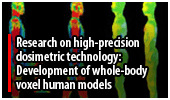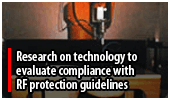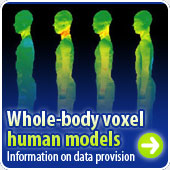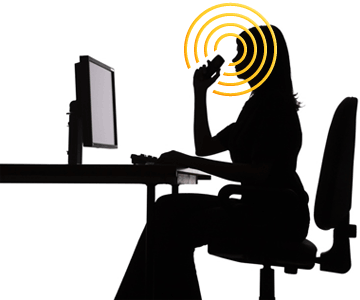
A variety of medical and biological experiments are being conducted in Japan and other countries, either to reconfirm the rationale for the radio frequency radiation protection guidelines, or to identify any unknown possible health effects of radio waves. To carry out medical and biological experiments, there is a need to realize the desired radio wave exposures on laboratory animals and to estimate personal history of radio wave exposure in epidemiological studies as precisely as possible.
At NICT, we take part in these medical and biological experiments and carry out physical and engineering studies to (1) develop exposure devices and systems that realize precise electromagnetic field exposures in laboratory animals and (2) conduct dosimetry to allow highly-precise quantification of personal history of radio wave exposure that are needed for epidemiological studies.
We currently have the following four research tasks.
Partial-body radio wave exposure experiments on the rat brain
Rats are often used as test animals for safety evaluations of various chemical and other substances. We have seen several experiments including localized exposure to electromagnetic fields conducted on the rat brain to simulate the conditions of mobile phone use by humans. At NICT, we have thus far developed several types of partial-body radio wave exposure systems used on rat brains.
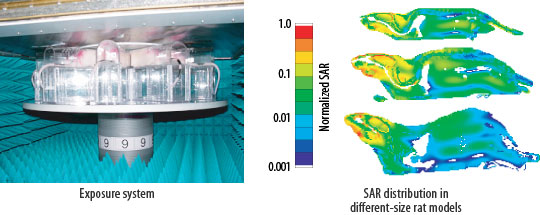
Rat-head radio wave exposure system (1)
This system consists of a small radio-anechoic exposure box and a 1/4-wavelength monopole antenna. Several rats are immobilized in plastic holders and placed in a radial pattern facing the antenna that is set up at the center of the ceiling. This enables simultaneous localized exposure to multiple rat heads (the ratio of average SAR over the brain to the average SAR over the whole body is 2.7 to 7.0). This exposure system has been used in long-term localized exposure experiments, etc., to investigate the effects of electromagnetic field exposure on cerebral carcinogenesis. The results showed no apparent effects on brain tumors at exposure levels within those stipulated in the radio frequency radiation protection guidelines.

Rat-head radio wave exposure system (2)
The above shows a system using an "figure-8" loop antenna. Compared with the existing exposure systems using a monopole antenna, this system realizes more localized exposure conditions for the head (the ratio of target-tissue to whole-body averaged SAR is greater than 30). With the "figure-8" loop antenna, it is possible to observe a variety of effects, in real time during the experiment, through the space between the antenna and the cranial window attached to the head of the rat. A cranial window is a transparent window embedded in the cranium for observation purposes. Use of this device enables the observation of possible reversible biological effects that may only occur during radio wave exposure. This exposure system has been used in experiments to study the effects on cerebral microcirculation dynamics, and localized exposure experiments in young rats, etc. The results showed no apparent adverse health effects at exposure levels within those stipulated in the radio frequency radiation protection guidelines.
Whole-body radio wave exposure experiments using fetal and neonatal rats
In recent years, the WHO (World Health Organization) and other organizations have recommended the conducting of experiments to evaluate the effects of radio waves during the fetal and neonatal periods. In order to simulate radio wave exposure from mobile phone base stations, we have developed a system for exposing radio waves of third-generation mobile phones (W-CDMA) for extended periods on the whole body of unrestrained fetal and neonatal rats.

Whole-body exposure devices on rats
In this system, the whole body of an unrestrained rat raised inside a cage is exposed to circular polarized waves emitted by a 3/2-wavelength orthogonal dipole antenna installed on the ceiling. Ideally 24-hour continuous exposure is possible. In actual experiments, however, radiating of radio waves was discontinued during observation of the rats and animal room maintenance and exchange, so the duration of exposure totaled 20 hours each day. Until now, it has not been possible to estimate dose of freely moving rats exosed to radio wave. We therefore assumed a variety of rat positions and placements, and statistically estimated their average dose, i.e., statistically averaged SAR. We used this system to conduct experiments in fetal and neonatal rats. The results showed that relatively high whole-body exposure of radio waves, which exceeds the radio frequency radiation protection guideline level for the general environment, had no adverse effects on rat growth, behavior, learning/memory, or reproductive capabilities.
Epidemiological studies on mobile phone use and brain tumors
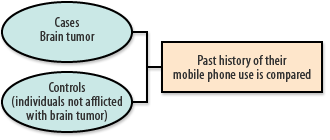
Pattern diagram of the case-control study
The International Case Control Study of Tumors of the Brain and Salivary Glands (the INTERPHONE Study) is currently being led and coordinated by the International Agency for Research on Cancer (IARC), based on a proposal by the WHO. Japan is among the thirteen countries participating in this collaborative study. These epidemiological studies gathered individuals who have developed brain tumor (cases) and individuals who have not developed brain tumor (controls) to compare their mobile phone use history. The results obtained in Japan found no relationship between the use and non-use of mobile phone terminals, cumulative years of use, and cumulative time of use, with the risk of developing brain tumor. No elevation of risk was seen, even in long-term users. At NICT, we cooperated with these studies from the dosimetric perspective, such as classification of mobile phone terminals based on intracranial SAR distribution during mobile phone use; and development of a method to estimate the intracranial electromagnetic field exposure levels vis-à-vis each brain tumor according to the type of mobile phone terminal, and to estimate the cumulative exposure volume.

Example of typical SAR distribution classified into 4 types
A study on symptoms caused by radio waves emitted from mobile phone base stations
The intensity of the electromagnetic field emitted from base stations and terminals of mobile phones cannot legally exceed the limits set by the radio frequency radiation protection guidelines. Some studies, however, have reported that people feel, and react to, the effects of electromagnetic fields at intensities below the guideline values. In response to these reports, a human study is under way in Japan to examine the possible psychological and physiological effects of electromagnetic exposure by the third-generation mobile phone (W-CDMA) system, and to collect objective evidence on whether humans can sense low-level electromagnetic fields, even at intensities below those set by the radio frequency radiation protection guidelines. At NICT developed an exposure system for this experiment which assumed that the subjects' whole body would be exposed to radio waves emitted from cellular base stations.

Whole-body exposure system for volunteer experiments
A guide horn antenna is placed inside a special shielded room lined with an absorber, and a subject is expposed to radio waves with an intensity of 10 V/m emitted from the antenna. Along with precise control of exposure level, because human bodies are actually exposed to the radio waves, the system incorporates safety features to prevent excessive exposure. As in the experiments, we employ a sitting-position voxel human-body model to conduct detailed dosimetry, and then confirm that the exposure is below the level stipulated by the radio frequency radiation protection guidelines. Radio waves were irradiated to groups of subjects who show MPRS (mobile-phone related symptoms), and to the control group, and the presence or absence of various symptoms, and the results of various tasks, etc., were compared. The results found no evidence of sensitivity to radio waves in the MPRS group, as in the control group. The findings also showed that, regardless of the presence or absence of radio waves, the subjects' performance of various tasks dropped because of fatigue or stress.

